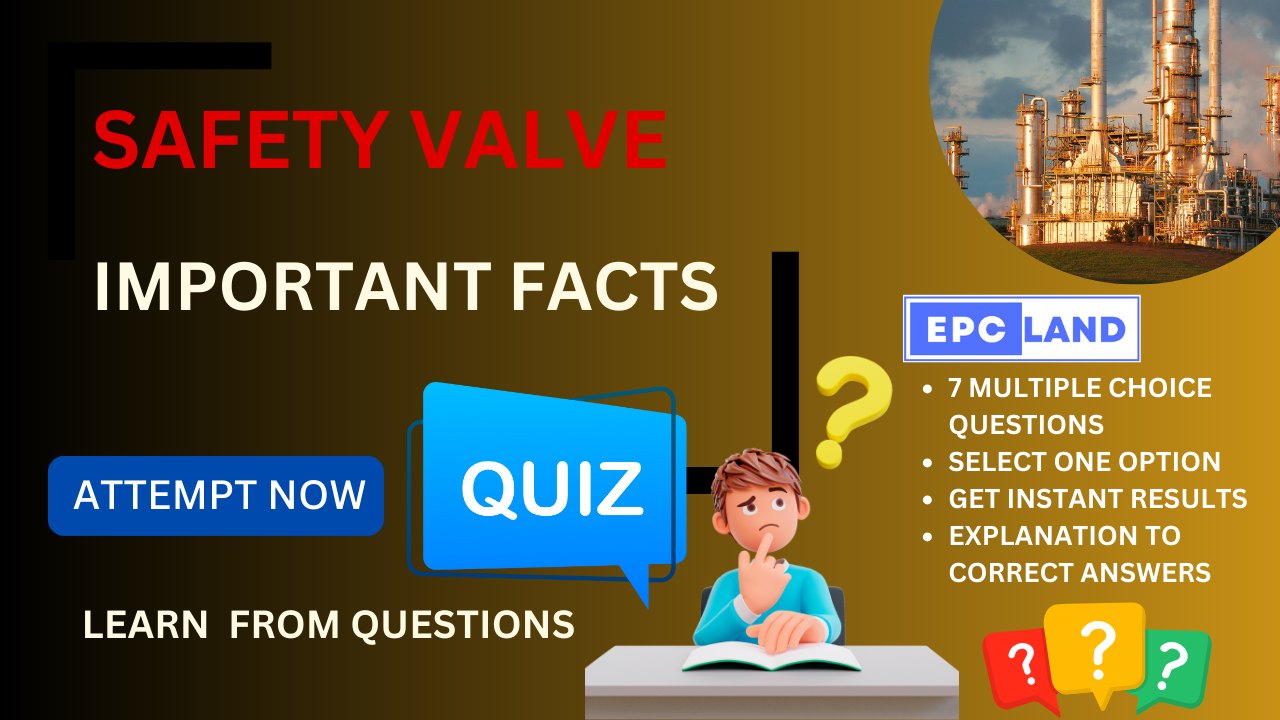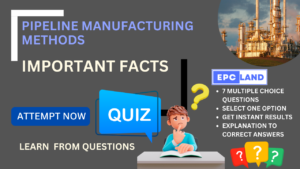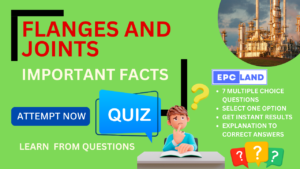1. Free Draining Inlet Piping in Safety Valve piping system
According to safety valve/blowdown system piping guidelines, what is recommended for the inlet piping to the pressure safety valve?
Explanation: The inlet piping to the pressure safety valve should be free draining to the line or equipment it protects.
2. Discharge Piping Elevation
How high above the highest platform should discharge piping from pressure safety valves on inert gas or steam systems terminate?
Explanation: Discharge piping should terminate at least 8 feet (2.5m) above the highest platform within a horizontal radius of 25 feet (8 m).
3. Safety Valve Discharge to Flare System
What is the recommended configuration for safety valve discharge piping that relieves into a flare system?
Explanation: Safety valve discharge piping into a flare system should free drain to the flare header and discharge to the top of the header.
4. Location of Pressure Relief Valves (PSV)
Where should pressure relief valves relieving to a closed flare header be located?
Explanation: Pressure relief valves relieving to a closed flare header shall be located above the header and be free-draining.
5. Inlet Line Size and Safety Valve Inlet Size
What is recommended when the inlet line size is higher than the safety valve inlet size?
Explanation: Wherever the inlet line size is higher than the safety valve inlet size, a reducer shall be installed close to the inlet of the safety valve.
6. Weep Hole for Relief Valve Discharge
What is the purpose of a weep hole in relief valve discharge piping for steam, air, or other non-flammable vapor or gas?
Explanation: Relief valve discharge piping for steam, air, or other non-flammable vapor or gas shall be equipped with a weep hole to allow drainage and prevent liquid accumulation.
7. Liquid-Phase Blow Down System Piping
What is the requirement for liquid-phase blow down system piping connected to a closed system?
Explanation: Liquid-phase blow down system piping connected to a closed system shall be self-draining to the blow down drum.
8. Pockets in Flare Header and Blow Down System
According to safety valve/blowdown system piping guidelines, what is prohibited?
Explanation: Pockets in the flare header and blow down system shall be prohibited according to safety valve/blowdown system piping guidelines.
9. Relief Valve Discharge to Atmosphere
What considerations should be taken when the relief valve is discharging to atmosphere?
Explanation: In case the relief valve is discharging to atmosphere, considerations include adequate support, reaction forces, and compliance with API RP 520.
Table of Contents
Don’t miss the Course on Effective Isometrics Management: Check Now
Enrollment Link
Recommended courses (Published on EPCLand)
- Complete Course on Piping Engineering
- Basics of Piping Engineering
- Piping Layout Engineering
- Piping Material Engineering
- Piping Stress Analysis
- Material Requisitions
- Piping Material Specifications
- Valve Material Specifications
- Plant Design & Layouts-OISD 118
- Isometric Management
Library of Technical Articles
Don’t miss out the collection of 15+ articles on following topics:
- Basics of Oil and Gas Industry
- Valves
- Testing
- Tank
- Piping Bulk Items
- Pipe
- Metallurgy
- Piping Materials
- Layout
- Instrumentation
- Heat Exchanger
- Type of Contracts
- Codes and Standards
- ASTM Standards
- Articles on Piping Specialty Items
Video details of Complete Course on Piping Engineering
Why Enroll in the EPCLand
Proven Track Record– PTR
Activities & Achievements before launching EPCLand
- Published more than 50+ short courses
- 3000+ Enrolments
- More than 3,500,00 Minutes of watch hours in the last 2 years
- 4000+ Students in 100+ Countries
- Rating of 4+ out of 5
- 1000+ YouTube Videos
- 8K+ Subscribers
What Students will Learn
- Codes & Standards of the Energy Sector
- Piping Material Engineering
- Piping Layout Engineering
- Stress Analysis
Interesting facts
- All the published courses have been developed by Industry Experts with more than 2 decades of experience
- Content is based on Practical experience and real-time problems.
- Content is designed and organized in such a manner that it can be easily grabbed.
- Complete website, Blogs and Quiz sections are Planned, Designed and published by myself (About me: Atul Singla)
- Complete flexibility of Time & Location, Students can access the content from anywhere & anytime
- Moreover, once enrolled, the content can be access as many times as you want, which helps in understand the fundamentals in a better way.
Conclusion
In conclusion, our courses are meticulously crafted by industry experts with over two decades of hands-on experience. The content is rooted in practical knowledge, addressing real-time problems. The material is thoughtfully designed and organized for easy comprehension. Every aspect, from the website to blogs and quizzes, has been planned, designed, and executed by Atul Singla, ensuring a comprehensive and seamless learning experience. With the flexibility of accessing the content at any time and from any location, students have the freedom to learn on their terms. Furthermore, enrollment grants unlimited access, allowing learners to revisit the material as often as needed, fostering a deep understanding of the fundamentals.



